McDonald’s Faces Decline as Low-Income Customers Depart

McDonald’s is experiencing a significant decline in traffic from low-income customers, a trend that highlights the widening wealth gap affecting consumer behavior. According to the company’s chief executive, Christopher Kempczinski, the fast-food giant has seen double-digit drops in visits from one of its core demographics, while higher-income customers have increased their patronage. This shift comes as many Americans grapple with rising costs across essential goods and services.
In the early 2000s, McDonald’s revitalized its brand with the introduction of the Dollar Menu. This initiative aimed to attract low-income consumers, offering items priced at just $1. The strategy proved successful, reversing a period of stagnation and contributing to a remarkable 33% revenue growth over three years. However, recent reports indicate that the fast-food chain’s pricing has risen so dramatically that its traditional customer base is feeling the pinch.
The surge in prices is attributed to increased costs for basic food items, including beef, as well as rising wages. Analysts like Adam Josephson have pointed out that many consumer companies, including those in the food, automotive, and airline sectors, are witnessing similar trends. “Happy Meals at McDonald’s are prohibitively expensive for some people,” Josephson stated, emphasizing the detrimental impact of inflation on low-income families.
A broader economic pattern is emerging, described by economists as a “K-shaped economy,” where wealthier consumers are able to maintain or increase their spending, while lower-income households are forced to cut back. This divergence is evident in various sectors. For instance, Delta Airlines reported a 5% decline in revenue from its main cabin, contrasted with a 5% increase in premium ticket sales.
The struggles faced by low-income households are underscored by rising consumer credit delinquency rates, particularly among those earning less than $45,000 per year. According to Rikard Bandebo, chief strategy officer and chief economist at VantageScore, these households have seen significant increases in delinquency rates since the expiration of COVID-19 stimulus programs. Despite recent reductions in inflation, many continue to face high prices and soaring rental costs.
A report from the Joint Center for Housing Studies at Harvard University indicates that in 2023, half of all renters in the United States, amounting to 22.6 million people, were cost-burdened, spending over 30% of their income on housing. This figure has risen sharply since 2001, with 27% of renters classified as severely burdened, spending more than 50% of their income on housing.
As the cost of dining out rises, limited-service restaurant prices have increased by 3.2% year over year, outpacing overall inflation. This upward trend is particularly challenging for low-income families, who spend a larger portion of their budgets on goods affected by tariffs and price hikes. According to Marisa DiNatale, an economist at Moody’s Analytics, wage stagnation is compounding these issues, making it increasingly difficult for lower-income households to afford basic needs.
McDonald’s has acknowledged that, from 2019 to 2024, the average cost of its menu items has risen by 40%. For example, the price of a Big Mac climbed from $4.39 in 2019 to $5.29 in 2024. Similarly, a 10-piece McNuggets Meal saw an increase from $7.19 to $9.19. These price adjustments reflect the company’s struggle with escalating operational costs, including labor and food prices.
The fast-food chain has also pointed fingers at the meat-packing industry, alleging price manipulation in a lawsuit against major companies like Tyson and JBS. The litigation has not resulted in any admissions of wrongdoing from the accused. Despite these challenges, McDonald’s chief financial officer, Ian Borden, noted that the company has managed to control its expenses better than many competitors.
In California, the debate surrounding fast food pricing has intensified, especially following the implementation of legislation that raised minimum wages for fast-food workers. The impact of this legislation remains contentious, with some fast-food owners claiming it has led to reduced hours and layoffs, while others argue that the wage increases have not adversely affected employment levels.
Despite its attempts to revive interest in budget-friendly options, such as a $5 McDouble meal deal, McDonald’s has struggled to regain its former customer base. The company reported a 3.6% decline in same-store sales in May, though there was a 2.4% increase in a recent quarter. This fluctuation suggests that while the company is making efforts to adapt, the economic realities faced by many consumers continue to pose significant challenges.
The changes in consumer behavior at McDonald’s reflect a larger narrative of economic inequality. As businesses across various sectors grapple with rising costs, the impact on lower-income households remains pronounced. Commentators like DiNatale observe that many businesses are hesitant to pass on higher costs to consumers, fearing further backlash from a population already stretched thin by years of rising prices.
In summary, McDonald’s decline in low-income customer traffic mirrors broader economic trends that highlight the stark disparities in consumer spending. As prices continue to rise, the fast-food giant faces an uphill battle to engage its traditional customer base while navigating a rapidly changing economic landscape.






